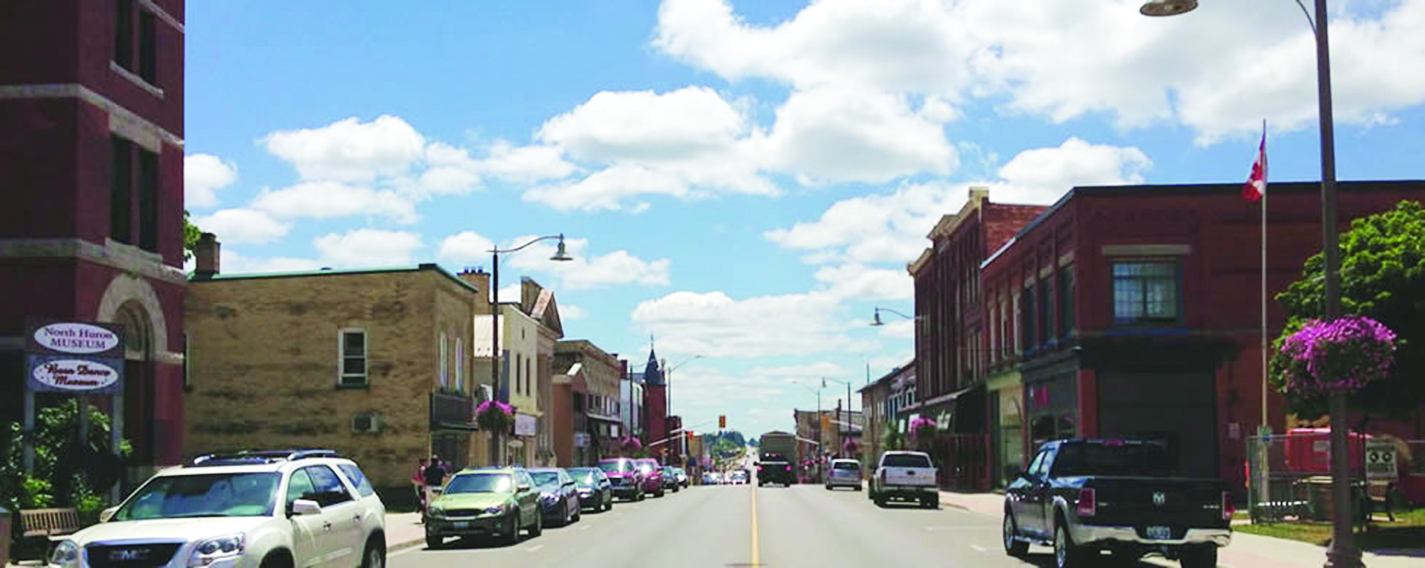Main Street Huron County - Highway 4
Much attention is given to Bluewater Highway (King’s Highway 21) as it carries travellers along the West Coast of Ontario, but we’d like to draw your attention a little inland.
London Road, or King’s Highway 4/Huron Rd 4, has a lengthy history, being one of the main conduits for settlement in the region. The highway as we know it was officially assumed as a provincial highway in 1920 from London to Elginfield, and then extended to Clinton in 1927. During the 1930s, the provincial designation was extended from Clinton to Flesherton, but was lost to provincial downloading and became Huron Road 4 from Clinton to the north end of the county just past Wingham where it becomes Bruce Road 4, and the responsibility of Bruce County.
This highway has the distinction of being the main thoroughfare of more towns and villages than any other road in Huron County, making it “Main Street Huron”.
A trip up Main Street Huron begins in Exeter, the jewel of the municipality of South Huron. The downtown remains a vibrant, bustling strip with a variety of interesting shops. One of our favourite places to stop is The Curry Corner, bringing the authentic flavours of India to the area. The highway continues north over a bridge that is adjacent to the MacNaughton Park, which hosts some beautiful gardens and a nature trail.
The town of Hensall, also known as the White Bean Capital of Canada sits alongside the highway with its proud agricultural heritage visible to travellers, with silos and grain elevators towering over the town. The main street which runs perpendicular to the highway harkens back to another era when farmers relied on local merchants for everyday purchases. Bring a cooler and pop into the retail outlet of Metzger’s Meats to pick up some award-winning bacon or a smoked pork chop.
The village of Kippen is barely more than a crossroads now but you can still see the remnants of the former general store and post office. As you leave town, you may notice a solitary elm close to the road that is the sole survivor of a string of trees that were slated for removal by the highway, but became the darlings of a group of tree-huggers who lobbied to save them. Four were saved more than a decade ago, but three have been lost in ensuing years. The remaining tree remains a popular photo spot in all seasons.
As you travel through the most agriculturally productive county in Ontario with flat, fertile fields that run as far as the eye can see along this section of Highway 4, with diverse farms producing everything from all manner of livestock, to crop production (soybeans, wheat, corn, hay and more!), orchards, greenhouses and maple syrup.
Brucefield is a charming village with several industries still thriving and a new toy store that is planning on beginning its own production factory.
Continuing along the road, you’ll notice the former air force base of Vanastra on your right. The village now features a historical walking tour that tells the story of radar and how the base contributed to the war effort during World War II. The giant frame that resembles a golf ball was once a dome covered in white tiles that housed the radar dish that now sits at the main intersection in Clinton, just further down the highway.
Just as you enter Clinton, before you cross the Bayfield River you’ll notice a small park on your right. The former Lions Park is now managed exclusively by the Ausable Bayfield Conservation Authority and features a short trail that follows along the river where you can explore the river up close, and may catch sight of beavers, which occasionally make their way into the park to build dams and lodges. To protect the waterway, they are quickly removed but when they are in the park their handiwork is amazing to see up close.
now managed exclusively by the Ausable Bayfield Conservation Authority and features a short trail that follows along the river where you can explore the river up close, and may catch sight of beavers, which occasionally make their way into the park to build dams and lodges. To protect the waterway, they are quickly removed but when they are in the park their handiwork is amazing to see up close.
The town of Clinton has long been an important junction in the county, as it stands at the crossroads of Highways 4 and 8, two important thoroughfares in first opening up the region to colonial settlement and now for commerce and trade to bring goods in and out of the area. The town is also close to the geographical centre of the county, giving it the moniker of “the heart of Huron County”.
The geography begins to change from the flat fields, to a slightly more rolling landscape, with sheep and cows grazing in fields bordered by acres and acres of corn, beans and winter wheat. The village of Londesborough is still a thriving community boasting a busy grain elevator, a popular bird feed company and one of the area’s largest greenhouse and garden supply business.
The short trip to Blyth will bring you around a curve and into view of several large iconic buildings. The Old Mill is a unique building on the edge of town that houses a retail outlet and a famous tannery that has long been a destination for leather goods and fashion.
Cowbell Brewing, at the corner of Huron Rds 4 and 25, is a relative newcomer to town but has been drawing crowds to the impressive “barn” that houses its restaurant and brewery since it opened to great fanfare in 2017.
 The downtown of Blyth boasts one of the most creative main streets in the region, with artisan markets, architects, publishing houses, printers, galleries and a professional theatre in the historic Blyth Memorial Community Hall. The Blyth Inn at the centre of the town is one of the oldest in the county, with the property boasting some manner of hotel operating continuously since 1856.
The downtown of Blyth boasts one of the most creative main streets in the region, with artisan markets, architects, publishing houses, printers, galleries and a professional theatre in the historic Blyth Memorial Community Hall. The Blyth Inn at the centre of the town is one of the oldest in the county, with the property boasting some manner of hotel operating continuously since 1856.
Before you leave town, you’ll notice the Blyth Greenway Trail recognizable for its iconic steel water tower. The trail is part of the Goderich–to-Guelph Rail Trail, and reminds the visitors and residents of the days when the small village was bustling with not one, but two rail lines and two busy stations running.
The village of Belgrave is the next stop along the route and the Belgrave Arena is one-of-a-kind, as it still boasts a natural ice surface. (This past winter has been one of the best seasons for skating on it in recent memory!)
Our final main street destination is Wingham, once celebrated as the smallest town in the world to have its own television station. Thanks to visionary Doc Cruikshank, the town boasted both a television station and the radio station famous for its weekly Barn Dance broadcasts.

The downtown is as pretty as it is practical, with a long street filled with businesses and services. The architecture of the downtown retail section is interesting with many historical buildings, like town hall, the former post office, an excellent example of a well-preserved rail station and many grand commercial blocks.
After your grand tour up Highway 4, you’ll see why we think of it as “Main Street Huron”. There are too many businesses and points of interest for an article, but we try to tell as many of these stories, and others, in every issue and our website www.stopsalongtheway.ca


